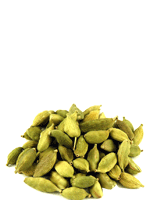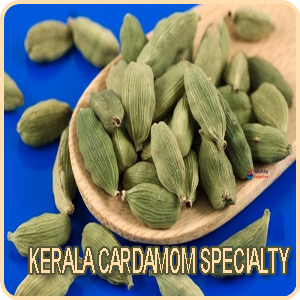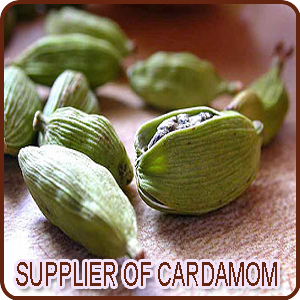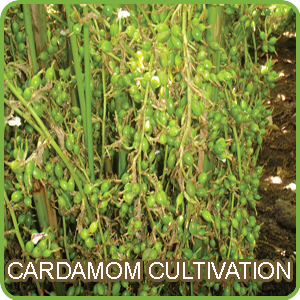 HISTORY OF KERALA CARDAMOM
HISTORY OF KERALA CARDAMOM
Cardamom also popularly known as "Ilachi" is native to South India and Gautemala. Cardamom is known as the Queen of Spices which was two hundred years ago grown wild in South Western India. It was the British who entrenched the cardamom plantations in India. Cardamom belongs to the ginger family with large leaf and is more of an aromatic herb with a pungent smell. The seedpods of the plant which has three chambers forms the main part of cardamom for which it is harvested. In India Kerala is the biggest producer of cardamom and supplies both for the local and the international market. The cardamom seed is the most common seasoning agent which is used in the cooking of India and Mid- Eastern countries. Cardamom flavored tea is very famous across the country.
 CARDAMOM IS ALSO KNOWN AS GRAINS OF PARADISE
CARDAMOM IS ALSO KNOWN AS GRAINS OF PARADISE
Cardamom which is also known as Grains of Paradise of the Western Ghats is also cultivated in other countries like Nepal, Sri Lanka, Guatemala, Mexico, Thailand, Indo China, Tanzania and Central America. The cardamom cultivated in India is supposed to be of the premium quality. Cardamom is mentioned in Sanskrit texts of the 4th century BC in a treatise on politics called Kautilya's Arthashasthra and in Taitirriya Samhita where it is used in offerings. Though India is the largest producer of cardamom, majority of the production goes into the local market while a partial proportion is exported to International markets. Whereas the cardamom cultivated in Gautemala is mainly for the export market. However at least 60% of the total world production of cardamom goes to the Arab countries. Cardamom apart from being used as a flavoring agent is also used for its medicinal properties which are also mentioned in Charaka Samhita, a medical compilation written during the 2nd century, BC.
 DURING THE 2ND CENTURY BC THE GREEKS WERE ALSO IMPORTING CARDAMOM
DURING THE 2ND CENTURY BC THE GREEKS WERE ALSO IMPORTING CARDAMOM
During the 2nd century BC the Greeks were also importing cardamom from the Eastern countries in the name of amomon. Though not very clear but still there were mentions about two different varieties of cardamom by the Roman writers. The most popular book Manasollasa or Book of Splendour which belongs to the 11th century had Indian cardamom in the list of ingredients required in the preparation of panchasugandha-thambula or 'five-fragrance betel chew'. The court of Sultan of Mandu used cardamom as flavoring agent for recipes like sherbets and rice dishes. The Portugese traveller Barbosa in 1524 has made mention about cardamom. By the time of Garcia da Orta in 1563 the international trade in cardamoms was well developed. The province of Kerala took exclusive possession of cardamom until colonial times and during the 19th century the British took over the establishment of cardamom as secondary cropping with coffee plantations.
 SPECIALTY
SPECIALTY
The botanical name of cardamom is Elettaria cardamomum which belongs to the Zingiberaceae, the ginger family. Cardamom is considered to be a very valuable spice and the third most expensive in the world next only to saffron and vanilla. This versatile spice native to the Western Ghats of India is used for both sweet and savory foods which impart a very unique taste and aroma to which it is added. The oil which is extracted from cardamom, the oleoresin is used in processing food.
There are some traditional medicines which are exclusively prepared from cardamom and are used in treating skin diseases and also help indigestion. The word cardamom is sometimes used for species of the closely related genus Amomum which are also members of the ginger family and hence the spice got from this is known as Amomum cardamomum.
 CARDAMOM VARIETIES AND PLANT TYPE
CARDAMOM VARIETIES AND PLANT TYPE
But however this is much larger than the green cardamom and is brown or back in color which gives a harsher taste and aroma. Of the black and the brown cardamom variety the former known as Amomum subulatum is the best known of these related species. The cardamom plant grows into a thick clump with 15 to 20 leafy shoots and can grow up to a height of 2 to almost 6 m. The leaves are sword shaped and a healthy leaf is long and dark green in color. The flowering stalk bearing the flowers is about 1m long and can even grow more than that. The flowers include both male and female which is pale green. One of the petals is white and streaked with violet. The actual part of the plant which is used is the fruit in the shape of oval and elongated. Each fruit has 3 chambers filled with small aromatic seeds, each about 3 mm long. It is these seeds which after the process of drying takes the straw color and used in flavoring and for other purposes.
 INDIA IS ONE OF THE MAJOR PRODUCER AND SUPPLIER OF CARDAMOM
INDIA IS ONE OF THE MAJOR PRODUCER AND SUPPLIER OF CARDAMOM
Though India is one of the major producer and supplier of cardamom the Middle Eastern countries are the consumers where they use it mainly in beverages like tea and coffee and as a flavoring agent for the baked products in Scandinavian countries. The Western Ghats in India cultivates more than 80,000 hectares of cardamom.
The extraction of oil from cardamom is getting more of commercialized. The cardamom oil and the oleoresin is got by crushing of fruits which is again used in various other industries as flavoring agent and for processing frozen foods, condiments, gelatins and beverages.
The oil extracted from cardamom is highly rich in fatty acids such as palmitic, oleic and linoleic and in 1, 8 cineole and alpha terpinyl acetate.
 SMALL PORTION OF THE OIL IS ALSO USED IN TOBACCO FLAVORING
SMALL PORTION OF THE OIL IS ALSO USED IN TOBACCO FLAVORING
A small portion of the oil is also used in tobacco flavoring, and in cosmetics, soaps, lotions and perfumes. Oleoresin is used as an oil substitute in similar products. The Ayurvedic field of medicine uses the oil in treating illness related to food poison, stomach disorders, urinary tract system, asthma, bronchitis and cardiac problem. The oil of cardamom is mixed with neem and camphor and used as a nasal medicine for treating cold and allergy. An infusion of cardamom can be used as a gargle to relieve sore throats, which has led to its use in cough sweets.
 TRADITIONAL MEDICINE- THE CAPSULE MADE OF CARDAMOM
TRADITIONAL MEDICINE- THE CAPSULE MADE OF CARDAMOM
As a traditional medicine the capsule made of cardamom is used in improving eyesight. Apart from being used in soaps and hand creams, cardamom is also used in cosmetics especially in treating areas of body affected with red pigmentation. Cardamom is used in the preparation of a Western medicine in Britain and Europe where it is used as a stomach stimulant. In Kashmir cardamom is an essential ingredient added to the most popular drink, kahwa and also to the Kashmiri black tea. An ancient paan recipe also uses cardamom as a main ingredient. The oleoresin extracted from cardamom is also used as a flavoring agent and preservative for food with a short shelf life like sausages. Cardamom is said to have antibacterial property and hence used in chewing gums.
 CULTIVATION
CULTIVATION
For the purpose of cultivation the plants are available in nurseries and is most commonly propagated either by seedlings or vegetative reproduction. However growth and yield is much faster when propagated vegetatively than by seedlings. This tropical plant does not grow like a tree and usually grows on the jungle floor. The leaves of the cardamom plant are used to wrap around fish, rice or vegetables to add give flavor to the food which is cooked. The seeds are sown specially in nurseries before 7-10 days as they are capable of working successfully in this period. Once the plant from the seedling is 1-2 years old it is then planted in the field mainly intercropped with pepper and coffee and grown under shade trees. In the third year harvesting of the fruit is carried out. Though the plant still remains green, the seeds inside the pods would have changed from white to brown or black. The fruits ripen over an extended period and are harvested every 3 to 5 weeks.
 PICKED FRUITS ARE WASHED AND GO FOR THE PROCESS OF DRYING
PICKED FRUITS ARE WASHED AND GO FOR THE PROCESS OF DRYING
Once the fruit is picked they are washed and go for the process of drying. Though in ancient times the fruits where mostly sun-dried now there are several machineries involving latest drying techniques which are used by the planters. As the drying process takes place, the water content is thoroughly evaporated resulting in the dried cardamom ready for its use. Once the crop is ready it goes for the auction from where it takes its further journey. The Cardamom Planters Association developed by the Spices Board of India assists the planters to auction their cardamom at a fair deal. Auctions are conducted every week and the management committee allows only the dealers holding license of cardamom to take part in the auction. These license holders are registered with the Kerala General Tax / Central Sales Tax Act and also under the Sales Tax of the respective States in which they are doing business.
 CARDAMOM IN THE AUCTION
CARDAMOM IN THE AUCTION
The dealers who are going to bid their cardamom in the auction will have to submit a registration form along with a deposit of Rs. 1000 / - by Cash or Demand Draft, and the amount is returnable at the end of the current auction season. At the end of each day's auction, every bidder shall make payment of the purchase considerations of the lots bid by him and confirmed at the auction by means of two cheques in favor of the auctioner, one for an amount calculated at 10 % of the total value, encashable within three days of the date of auction and the other for the balance of 90 % encashable within 13 (thirteen) days of the date of auction.
 HISTORY OF KERALA CARDAMOM
HISTORY OF KERALA CARDAMOM CARDAMOM IS ALSO KNOWN AS GRAINS OF PARADISE
CARDAMOM IS ALSO KNOWN AS GRAINS OF PARADISE DURING THE 2ND CENTURY BC THE GREEKS WERE ALSO IMPORTING CARDAMOM
DURING THE 2ND CENTURY BC THE GREEKS WERE ALSO IMPORTING CARDAMOM  SPECIALTY
SPECIALTY
 CARDAMOM VARIETIES AND PLANT TYPE
CARDAMOM VARIETIES AND PLANT TYPE INDIA IS ONE OF THE MAJOR PRODUCER AND SUPPLIER OF CARDAMOM
INDIA IS ONE OF THE MAJOR PRODUCER AND SUPPLIER OF CARDAMOM
 SMALL PORTION OF THE OIL IS ALSO USED IN TOBACCO FLAVORING
SMALL PORTION OF THE OIL IS ALSO USED IN TOBACCO FLAVORING TRADITIONAL MEDICINE- THE CAPSULE MADE OF CARDAMOM
TRADITIONAL MEDICINE- THE CAPSULE MADE OF CARDAMOM CULTIVATION
CULTIVATION
 PICKED FRUITS ARE WASHED AND GO FOR THE PROCESS OF DRYING
PICKED FRUITS ARE WASHED AND GO FOR THE PROCESS OF DRYING CARDAMOM IN THE AUCTION
CARDAMOM IN THE AUCTION

